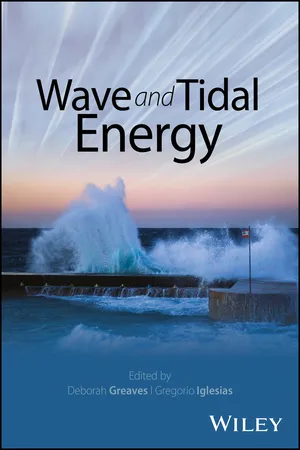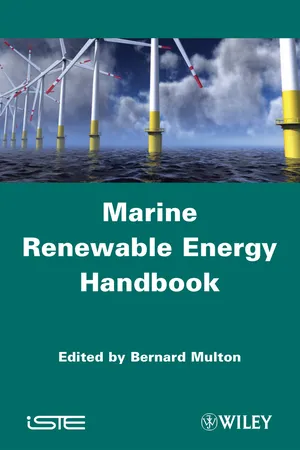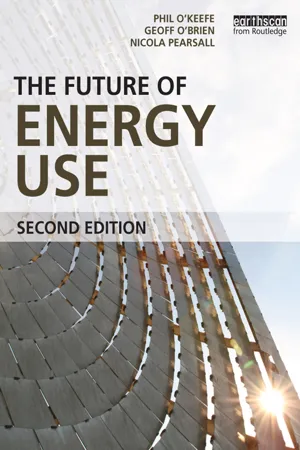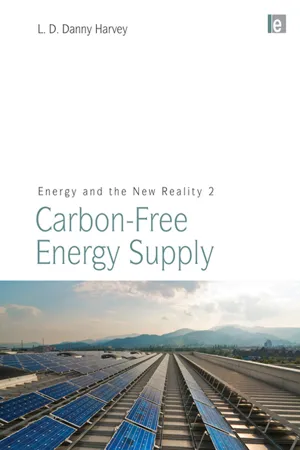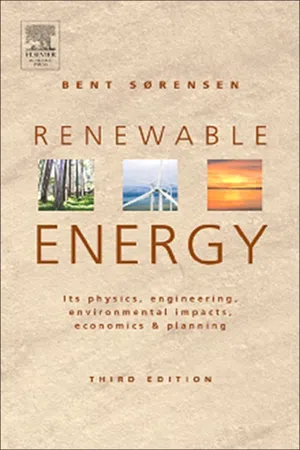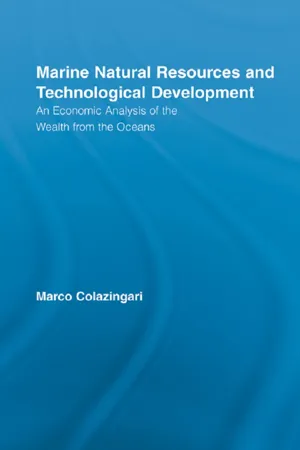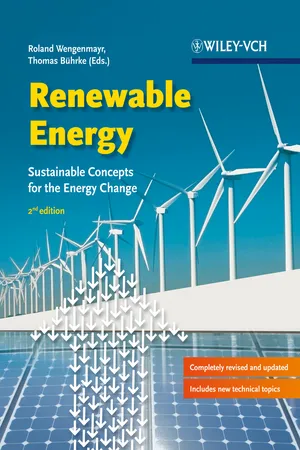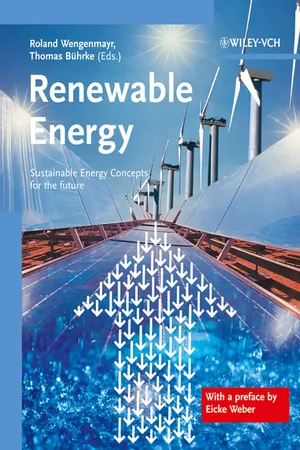Geography
Wave Energy
Wave energy refers to the renewable energy harnessed from the movement of ocean waves. It is a form of kinetic energy that can be converted into electricity using various technologies such as wave energy converters. Wave energy has the potential to provide a sustainable and clean source of power, particularly in coastal regions with strong wave activity.
Written by Perlego with AI-assistance
Related key terms
8 Key excerpts on "Wave Energy"
- eBook - ePub
- Deborah Greaves, Gregorio Iglesias(Authors)
- 2018(Publication Date)
- Wiley(Publisher)
Chapter 12 .The challenge for Wave Energy is how it can be harnessed and converted to useful power (e.g. electricity or desalination) in a cost-effective manner. Over the centuries numerous patents and designs for Wave Energy conversion have been proposed; and whereas in the wind sector, designs have converged to the three-bladed horizontal axis turbine, in Wave Energy many very different approaches are still being explored. Wave Energy absorption is a complex hydrodynamic process that is often counter-intuitive, and many early failures in Wave Energy lacked a proper understanding of these processes. The hydrodynamics of Wave Energy converters (WECs) is a sub-area of surface-wave hydrodynamics and naval architecture in which the theory of marine hydrodynamics have been developed over centuries for the design of ships and offshore oil and gas structures. However, Wave Energy extraction and how it may be maximised brings in new challenges, and WECs have some clear differences from these traditional offshore structures for which the theory has been developed and applied. For example, WECs tend to be far more dynamic than oil and gas structures. Usually the dynamics of the WEC is what drives the energy conversion system and so systems may be designed to maximise response in waves by designing the WEC to be close to resonance in typical wave conditions. For offshore oil and gas structures and ships, however, the typical design strategy is to ensure that natural frequencies of the systems are far from the wave frequency in order to prevent and restrict unwanted motions, which may limit drilling and offloading operations in offshore structures and cause discomfort in ships. WEC response is often further refined during operation in order to match encountered wave conditions, and this means that tuning and control should be included in the hydrodynamics of WEC design. Furthermore, whereas a ship will be able to take action to avoid storms, a wave farm is designed to operate in an energetic environment and to survive extreme conditions. - eBook - ePub
- Bernard Multon(Author)
- 2013(Publication Date)
- Wiley-ISTE(Publisher)
It was an article by Professor S. Salter [SAL 74] of the University of Edinburgh, published in the journal Nature in 1974, and simply entitled “Wave Power”, that marked a turning point and re-awakened scientific interest. This resurgence of research into Wave Energy conversion machines, at the time, was concentrated mainly in European countries and Japan. [CLE 02] contains an overview of the development of such technology in Europe in the late 20 th Century. Since then, the number of projects has increased considerably, and the research effort has spread to other continents. An up-to-date summary of the main technologies used can be found in [FAL 10]. 11.1. Presentation of the Wave Energy resource Figure 11.1. Mechanism of the creation of waves The waves are a by-product of the wind, which in itself is a by-product of solar energy. The wind creates movement in the upper layer of the water in open sea, giving an undulating form to the surface. These undulations are very small at first, then increase in size as the wind continues to blow and separate waves merge to form larger ones; there is an exchange of energy associated with this. They propagate in the form of gravity waves, with very little loss of energy, as long as the depth of the water is greater than the wavelength. Thus, waves are created in the open ocean, and the energy they contain is dissipated when they approach the coast, in shallower waters. Note that here, we speak of swell and waves synonymously; the difference between these two terms lies in the spectral typology relating to sea states (their distribution in terms of frequency and direction), but has no bearing on our argument. The energy transported by waves is the sum, in equal parts, of kinetic energy linked to the velocity field of water particles, and potential energy linked to the deformation of the fluid environment around its position on the surface plane - eBook - ePub
- Geoff O'Brien, Nicola Pearsall, Phil O'Keefe(Authors)
- 2010(Publication Date)
- Routledge(Publisher)
Wave Energy is extracted from ocean waves which are generated by the action of wind passing over a large stretch of water. Anyone who has been hit by a large wave knows how powerful they can be. The most powerful are those with a long period (the time taken for successive peaks to pass a given point) and great height, and they mainly occur in deep water because inshore waves lose much of their power through friction from the sea bed. Even so, coastal waves can have a very considerable average energy.Figure 7.40 shows the average annual energy per metre of wave in various parts of the world. As with other renewable energy technologies, the calculation of the resource relies on technology assumptions and an estimate of the percentage of the energy in waves that could be extracted economically. Wavenet, a network of experts on Wave Energy, have suggested a technical resource of 5–20TWh/year for near shore devices and 140–750TWh/year for offshore devices, the wide range reflecting the fact that the energy extraction depends on both the wave regime and the nature of the device (Wavenet, 2003).Energy in wavesThe energy in a wave consists of the kinetic energy of the moving water, and the potential energy associated with the peaks and troughs above and below mean sea level. For simplicity, let us consider a single wave with a wavelength λ (the distance from crest to crest) and a wave period T (the time between the passage of one crest and the following crest past a fixed point). The velocity at which the Wave Energy moves is given by V = gT/2π and the wavelength is related to the wave period by λ = VT = gT2 /2π.Figure 7.40 Average annual Wave Energy per metre at selected sites (MWh)In both these relationships, g is the acceleration due to gravity.The total energy per unit surface area of the wave is given byE = ½ρga2where ρ is the density of sea water and a is the amplitude of the wave (the height of the crest from mean sea level, or half the height from trough to crest). The power per metre length of wavefront isP = EV= (1/8π) ρg2 a2 T orP = 3.9a2 T (kW)when a is in metres and T in seconds.For a wave of 1m amplitude and a wave period of 10 seconds, the power/metre is then 39kW. The length of such a wave would be about 150m, so these are, for example, the long Atlantic rollers which sweep into the west coast of Great Britain. - eBook - ePub
Energy and the New Reality 2
Carbon-free Energy Supply
- L. D. Danny Harvey(Author)
- 2010(Publication Date)
- Routledge(Publisher)
A long floating structure aligned parallel with the wave direction. Movements along its length can be selectively constrained to produce energy. It has a smaller area perpendicular to the waves than a terminator, so it experiences smaller forces4 Other 5Source: IEA (2006d)Table 7.1 outlines the various Wave Energy technologies under development and the number of projects of each type identified by IEA (2006d). The large number of different technologies still under development indicates that the level of understanding is not sufficiently advanced to show which concepts will be the most cost effective.Figure 7.2 illustrates two possible Wave Energy conversion devices: an onshore oscillating water column device and a floating ocean wave converter buoy. There are many concepts for floating offshore devices, all of which would be able to take advantage of the greater energy in waves in deeper water. These include the point absorber and various overtopping devices (in which waves spill into a slightly elevated floating basin, then drain through a low-head turbine).Figure 7.2Wave Energy conversion devicesNote: Top, a shoreline ocean wave converter; bottom, a floating ocean wave convertor buoySource: Khan and Bhuyan (2009)Wave Energy, like wind energy, is variable in time. However, the available Wave Energy can be accurately predicted 24–48 hours in advance through the use of satellite remote sensing of surface winds and wave heights over entire ocean basins. This in turn reduces the fossil fuel spinning reserve that would otherwise be required in most jurisdictions to rapidly compensate for fluctuations in power production (as discussed in Volume 1, Chapter 3 , subsections 3.1.6 and 3.2.6).7.3 Tidal EnergyTides are produced by the gravitational attraction of the moon and sun on the waters of the ocean. In fact, with regard to the moon, there are two factors at work: gravitational attraction as well as a centrifugal effect. - eBook - ePub
- Bent Sorensen(Author)
- 2004(Publication Date)
- Academic Press(Publisher)
Fig. 3.48 a more detailed map of wave power availability for the north European region is shown, based on the iso-power lines estimated in initial assessments of wave power in the United Kingdom, supplemented with estimates based on data for the waters surrounding Denmark. One might note the rapid decrease in power when passing the Hebrides in approaching the Scottish coast from the Atlantic and also when moving southwards through the North Sea.Figure 3.48. Contours of estimated equal annual average wave power in the North Sea, adjacent straits and a part of the North Atlantic Ocean (unit: kW m−1 )(based on United Kingdom Energy Technology Support Unit, 1976 ).The variability of wave power may be described in terms similar to those used for wind energy. Figure 3.49 shows the power duration curves for Station India in the North Atlantic, based on all year or the summer or winter periods only, as in Fig. 3.46 . Again, the occurrence of periods of low and high power depends markedly on seasonal changes.Figure 3.49. Time duration curves for wave power at Station India (59°N, 19°W) in the North Atlantic for the whole year (solid line) or only summer or winter (dashed lines)(based on Mollison et al., 1976 ).Waves in a climatic context
As in the case of wind energy, little is known about the possible impact of large-scale energy extraction from wave power. One may argue that the total amount of energy involved is so small compared to the energy exchanged by atmospheric processes that any climatic consequence is unlikely. However, the exchange of latent and sensible heat, as well as matter, between the ocean and the atmosphere may, to a large extent, depend on the presence of waves. In particular, the rates of transfer may be high in the presence of breaking waves, and the extraction of energy from the wave motion may prevent the waves from developing the wave profile to the point of breaking. Thus, a study of the environmental implications of Wave Energy utilisation, which seems to lend itself very naturally to computer simulation techniques, should be undertaken in connection with proposed energy extraction schemes. As suggested in previous sections, this is likely to be required for any large-scale use of renewable energy, despite the intuitive feeling that such energy sources are “non-polluting”. Yet the limited evidence available, mostly deriving from analogies to natural processes, does suggest that the results of more detailed analyses will be that renewable energy flows and stores can be utilised in quantities exceeding present technological capability, without worry about environmental or general climatic disturbances. - Marco Colazingari(Author)
- 2013(Publication Date)
- Routledge(Publisher)
Waves are moved primarily by winds, which, in turn, are stimulated by solar energy. The different heating that the Earth receives from the sun produces low and high pressure in the atmosphere, which interaction produces winds. Winds transfer some of the energy to the water through friction between air and water molecules. The size of the waves depends on the wind speed, the length of time and the distance—or fetch—the wind blows. There are great variations in wave power level but in principles the power available in a wave is proportional to the square of the wave height (amplitude) and to the wave period, or period of motion. A commonly used yardstick to rate waves’ potential is the energy flux, which refers to the energy in kilowatt transported in each meter of wave crest length. Long- period, large-amplitude waves have an energy flux of 40–50 kW/m (CRES 2002). The global wave power potential, which is the greatest among marine renewable, has been estimated between 8,000 and 80,000 TWh per year (IEA 2003), corresponding to 1–10 TW. The World Energy Council estimates the wave potential at 2 TW (Thorpe 1999).Wave power varies seasonally and the wave resource at the development site is, of course, a critical factor in assessing the efficiency of the power plant. Wave Energy is at its strongest power in ocean depths of at least 50 m, before the wave loses energy because of the friction with a shallower seabed. The best locations for exploiting wave power are found at temperate latitudes between 30° and 60°. Waves considered useful for energy production vary from 40 to over 300 meters in length (EPRI 2004) and the best sites for wave-power plants must have more than 30 kW/m2 of wave power. More powerful waves (up to 70 kW/m and more) would destroy any device (see Figure 4.3 ).Figure 4.3 World Wave Energy Source. Wave Power in kW/m. Source: IEA-OES (2003).Wave Energy Converters (WECs) transform the kinetic energy of the moving water into electric power through a generator. The power input is the low-speed, high-force wave motion that must be converted to the highspeed, low-force power output of the electric generator. This mismatch can be overcome in different ways. Current technology is able to achieve power conversion by means of hydraulic, hydrodynamic and pneumatic devices. Even though there has been extensive research and development of WEC technology, it only began in the 1970s as a reaction to the oil crises and the subsequent rally of energy market prices. However, in France, way back in 1799, Girard & Son patented a technique to convert the ocean’s Wave Energy into a useful form of energy. In theory, as water is 832 times denser than air, it should be possible to get the same amount of energy from the water motion with a device much smaller and cheaper than a wind driven turbine. Although similar to wind turbines, underwater turbines are in fact much smaller and have a slower motion. On average, a water turbine has a dimension of about 9 m against the 90 m of a wind turbine and turns at about 30 rpm (revolutions per minute) against the 60 rpm of a wind turbine. In 1994 the EU Commission started a research program on WECs technology, including studies, financing projects with technical feasibility and the formation of the European Thematic Network on Wave Energy in order to coordinate collaborations among European countries. WECs are expected to provide in the near future an efficient, reliable, cost-effective and environmentally friendly source of electrical power. Some European governments, in particular the UK and the Scandinavian countries, have programs to develop this renewable energy sector by means of financing scientific research and experiment of prototypes.- eBook - ePub
Renewable Energy
Sustainable Energy Concepts for the Energy Change
- Roland Wengenmayr, Thomas Bührke, William D. Brewer(Authors)
- 2013(Publication Date)
- Wiley-VCH(Publisher)
Wave Power Plants
Energy Reserves from the Oceans
BY KAI-UWE GRAWAn old dream of humanity is to make use of the almost immeasurable energy of ocean waves. Their destructive power has however up to now not permitted any economically reasonable design to survive for long, although there have been many promising attempts and approaches.The reduction in carbon dioxide emissions, which is increasingly urgent and is a major goal of governments and societies, has conferred a new significance on Wave Energy – as on all renewable energy sources. Interest in Wave Energy power plants, which could make appreciable contributions to the world’s energy supply, is steadily growing. The use of Wave Energy for generating electric power has been under investigation for many decades. However, the countless, sometimes extremely naive suggestions for the application of Wave Energy have given this renewable energy source a dubious aftertaste in the public mind. But the long-term commtiment of a few research teams is now leading to a rethinking of this view.The ocean waves contain inexhaustible reserves of energy. They are estimated to store around ten million terawatt hours of Wave Energy per year. This makes them, in principle, very attractive as an energy source. However, large waves can deploy a destructive force which makes huge demands on the stability of the wave power plant under load. It is thus particularly interesting to employ wave power plants precisely where the force of large waves must in any case be broken: along coastal protection installations. Conventional breakwaters only reflect or dissipate the Wave Energy without making use of it. Wave power plants, in contrast, extract the energy and convert it into useful electric power. Furthermore, the use of a breakwater as the structure for a power plant reduces the cost of the plant which is integrated into it. Figure 1 shows a new wave power plant in the Spanish harbor Mutriku, whose construction was supported by the EU. With 16 Wells turbines, each delivering 18.5 kW, it can supply 250 households with electrical energy. Wave power plants which convert energy without fulfilling any protective function can even take the form of free-floating installations in the ocean (Figure 2 - eBook - ePub
Renewable Energy
Sustainable Energy Concepts for the Future
- Roland Wengenmayr, Thomas Bührke(Authors)
- 2011(Publication Date)
- Wiley-VCH(Publisher)
The deployment of this technology for coastal protection plays in important role in particular in India and in Japan. In the U.S.A. and Europe, it was at first investigated only very hesitantly. In general, most Wave Energy is available on the Western coasts of the big oceans, i.e. on the North and South Pacific coasts of America, on the Atlantic coasts of Europe and (South) Africa, on the Indian Ocean coast of Australia, and on the South Western coast of New Zealand. Precisely for this reason, the coupling of energy extraction with coastal protection is one of the few possibilities of making the use of Wave Energy economically attractive. Large coastal protection facilities however are not without side effects on the ecological system; but there has as yet been no research on this subject.The Formation and Propagation of “Gravity Waves “The major portion of the energy which is stored in ocean waves is transported by so-called gravity waves (Figure 3 ). They are initiated by the wind and their motion is governed almost entirely by gravitation. Figure 3 also illustrates the forces which activate the waves: short to medium waves are mainly produced by the wind, longer ones by air-pressure differences due to weather fronts or by earthquakes (tsunamis); extremely long waves are due to the tidal forces. The figure also shows the three forces which in general determine the propagation of the waves: surface tension, gravitation, and the Coriolis force. This last force is due to the Earth’s rotation; it is weak and has a noticeable influence on waves only when they are several kilometers long. The surface tension of the water is also a very weak force. It is important only for waves that are shorter than about one centimeter (about half an inch): such waves are deformed by the surface tension. In all other cases, gravity waves predominate. The force of gravity pulls the water in the wave crests down towards the troughs and thus tends to equalize the differences in height.Fig.2The MIGHTY-WHALE OWC of Japan’s Marine Science and Technology Center (JAMSTEC) was commissioned in 1998. this pilot plant is 30 m (100 ft) wide and floats in water at a depth of 40 m (130 ft); its output power is 110 kW.
Index pages curate the most relevant extracts from our library of academic textbooks. They’ve been created using an in-house natural language model (NLM), each adding context and meaning to key research topics.
